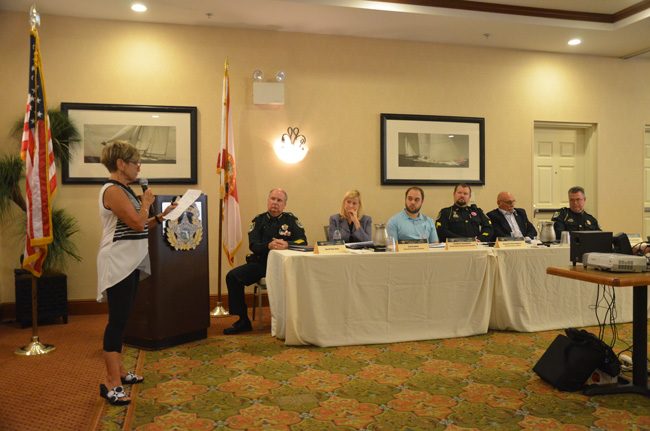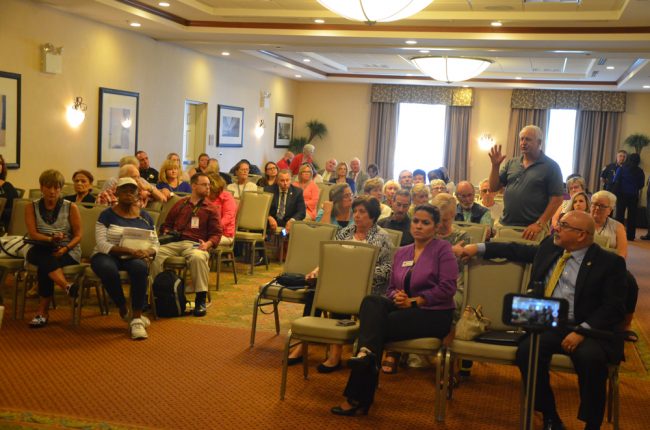
When government agencies put committees and task forces together, the question is always whether those initiatives will be ends in themselves, like publicity stunts, or genuine efforts to get something done.
The question could have been fairly asked of Flagler County Sheriff Rick Staly’s convening of a task force to study domestic violence—not its prevalence in Flagler County, where 600-odd such cases are reported every year point to the certainty of a serious problem, but the more challenging questions of what to do about it and how to make immediate, measurable improvements.
Judging from the Sheriff’s Office’s own response even before the task force presented its conclusions and proposals in a public meeting this afternoon, it’s anything but a publicity stunt: several substantial changes are already in the works, and a January meeting will be scheduled expressly to follow up on what further initiatives have been developed, and question why some have not.
As to what’s already happening:
The Sheriff’s Office worked to start a domestic-violence intervention program, the first of its kind in the county. It was proposed by two of the five task force sub-committees, and its first meeting in Bunnell took place last week. The program is funded by offenders directed into it by the judiciary, so it should not be a cost to taxpayers.
The Sheriff will devote a detective full-time to domestic violence cases in January, also a recommendation of one of the subcommittees. The detective will work toward ensuring that more prosecutions are successful, and fewer victims drop cases, as happens so often in domestic violence situations.
The agency has also already implemented another key change, addressing the lesser-known victims of domestic violence: children who are not directly being abused but who witness their mother or father being abused. Now, when deputies make a domestic violence arrest in a household with children, the School Resource Deputy based at the school that the child from that household attends is informed. The following day—when a parent would have spent the night in jail, as is required by law in domestic violence arrests—that child’s counselor and teachers will be in the know and provide what assistance they can to ensure that the child doesn’t feel isolated or overwhelmed. Staly said there are no issues of privacy at that point—except for the handling of the child’s issues within the school—since the arrest triggers a public process.

The sheriff said he anticipates that “domestic violence will increase before they decrease.” To make the point, he noted that since the June meeting, two more murders were recorded in the county, both of them involving one family member killing another—a son killing his mother, a man killing his cousin. Aggravated domestic violence has fallen 14 percent since the June meeting but less serious domestic violence cases have seen a 6 percent increase More broadly, Staly said offenders should now be aware that addressing domestic violence is a priority while victims “know they have a community that will support them form the family life center to the sheriff’s office to the prosecutors to the various committees.”
At least to the extent that news of the initiative is getting out: a fourth initiative by the Sheriff’s Office is a video public service announcement produced with the Sheriff and Trish Giaccone, the executive director of the Family Life Center, a shelter for victims of abuse.
At today’s wrap-up meetings leaders of the various committees presented their findings, some of which were detailed here earlier this week. The subcommittees included social services, mental health and medical services, education, faith-based services and criminal justice.
In June the Sheriff projected that today’s meeting would result in an actual report. But the work the sheriff was referring to was not exactly a report but a collection of the five committees’ work, in bullet-point format, without a synthesizing narrative or a combined set of conclusions. That may prove to be a vulnerability in the initiative’s long term: there is no unified, focused vision so much as a set of strong but disparate proposals, resented without a sense of priorities, factual bases or much research, whether into funding streams or into the nature of the problem, two factors that would have helped steer the next steps in the initiative. The proposals, in other words, don’t appear to have gone much further than the brainstorming stage to a more analytical form. (See below.)
Separately, the subcommittees provided several clear ideas.
Carrie Baird, who chaired the dozen-member social services committee, said the group identified three strategies: providing training to all those who, in their daily work, might encounter domestic violence or victims of domestic violence so as to know how to refer or connect a victim of domestic violence to the right services. Those may include employers, teachers, neighborhood watch participants, first responders and emergency room staff.
Baird’s group talked of a recurring theme across subcommittees: changing the way domestic violence is referred to and understood so as to broaden its definitions on one hand while ensuring that for those who come in contact with victims of domestic violence, measures exist to accommodate for the fact. Social service agencies, for example, should make sure that offices give clients private and safe places from where to speak or make calls. “Safe zones” could be established outside of offices, whether churches or other places. A 24-hour hotline would also be key.
The committee is also seeking a legislative change so that victims of domestic violence might be eligible for subsidized child care. Currently, parents residing in a shelter are eligible, but victims not in a shelter are not necessarily so. Baird pitched that request directly to Rep. Paul Renner and Sen. Travis Hutson, the county’s two lawmakers, in a community meeting with its legislative delegation later in the day. As for Flagler County’s shelter—the Family Life Center—it’s “busting at the seams, we need more capacity there,” Baird said. The shelter is a non-profit, supported by a combination of private donations and local county government support, but cities do not contribute. There’s also need for transitional and affordable housing.
Sgt. Chris Ragazzo, who chaired the education committee, stressed the need for children not to learn behaviors they witness in abusive households. He spoke of the problem’s vastness from his own perspective. “It’s a whole broader spectrum that I didn’t even think about,” he said, referring to his status as a cop. But he’s hoping to see better awareness of the issue, including better explanations as to why cops don’t always make arrests in cases of domestic violence.
Jack Bisland, the undersheriff who led the overall task force and chaired the criminal justice subcommittee, applauded the addition of a detective to domestic violence cases and said one of the ways to undermine offenders is to out them: “The more people know about that behavior, the more power it takes away from the offender,” he said.
Bisland later said the Sheriff’s Office stepped up to enact actual proposals: it’s now up to other segments of the community to do likewise. January’s meeting will measure that success.
![]()
Domestic Violence Task Force’s Findings (2017)
Click to access Domestic-Violence-Summit-Follow-up-Presentation-FINAL.pdf





























Pogo says
This is an impressive beginning.
Yourstruly says
They all look really enthused!!!
Just sayin' says
This is to the man in the white truck with the two ladders on top that was parked next to us a few nights ago on state road 100 and seminole woods at the red light. We heard you yelling at your female passenger and then saw you hit her and head butt her. We got a good look at you but your lucky we could not get your tag number. But I hope the lady that was getting beat on reads this and goes for help. We will eventually see you again and will get your tag number and report you. This is a small town!!! Just a matter of time scumbag!!
r&r says
Why do we have to rent a hall from the Hilton when we have all these nice new buildings like city hall and all the government buildings along SR 100 ?????????????????
Dave says
Smh these officials are wasting our taxpayer money on non sense to fluff themselves up, what’s the number cause of domestic violence? Money. And the first thing you do is make up a rule that makes them pay. Smh
Donna McGevna says
What is the date in January for this very important meeting so everything has the timing and can schedule to attend and get involved from the community?